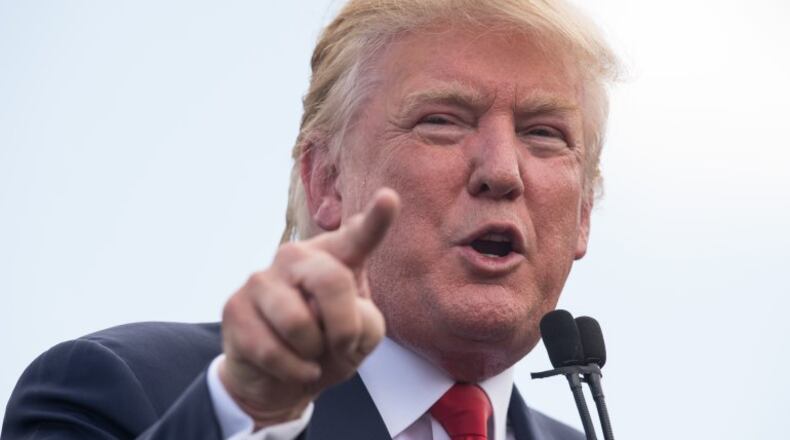The fiscal 2019 budget, released on the White House website late Monday morning, would show deficits of more than $900 billion from 2019 through 2022. The deficit this year is $832 billion.
But the budget is the clearest document of the president’s priorities:
* He’d like to spend $13 billion in new money to fight the opioid epidemic,
* $23 billion to build a border wall;
* and wants a federal infrastructure plan that would spend some $200 billion over 10 years on new roads and bridges.
President Donald Trump Monday proposed a $4.4 trillion federal budget that would beef up spending for the military, slash spending on non-military federal programs and – most controversially, for budget hawks – fail to balance the budget within the next decade.
In fact, the fiscal 2019 budget, released on the White House website late Monday morning would show deficits over $900 billion from 2019 through 2022. The deficit this year is $832 billion.
The budget is Trump’s blueprint for how he’s like to spend federal dollars and is merely a proposal, not a law. And, in what has become tradition dating back to the Obama administration, it will likely be virtually ignored by Congress – probably more so in light of the fact that Congress last week agreed to a two-year budget plan that increased spending across the board.
The latter proposal drew the most headlines. Within minutes of releasing his proposed budget, Trump outlined an infrastructure plan which would pour $200 billion in federal dollars into roads, bridges, ports and airports but would rely heavily on states and local governments to help pay for an estimated $1.5 trillion in investment over the next decade.
Sen. Rob Portman, R-Ohio, called Trump’s infrastructure proposal “a good starting point for discussion.” He said he’s hopeful that Congress can streamline the permitting process to allow quicker rebuilding of roads and bridges.
Sen. Sherrod Brown, D-Ohio, by contrast, said the plan would pass the cost of infrastructure onto drivers, cities and counties through tolls and local tax increases.
“Accounting gimmicks don’t build bridges,” he said.
RELATED: How budget could impact Wright-Patterson Air Force Base
Ohio impact
Trump proposes $13 billion — $3 billion in this fiscal year, $10 billion in fiscal 2019 — to fight the opioid epidemic. In Ohio, 4,050 people lost their lives to unintentional drug overdoses in 2016, with fentanyl and related drugs accounting for 58 percent of those deaths.
Trump’s budget request would include state grants to fight opioid abuse; new resources for drug courts; expand coverage for medication-assisted treatment in Medicaid and Medicare; and allocate $381 million to Veterans Affairs to reduce over-reliance on opioids for pain management. It also includes dollars for a media campaign aimed at educating the public about the dangers of opioids.
“Today’s budget is a good starting point for funding American priorities in the coming year,” said Rep. Mike Turner, R-Dayton, who said he was happy that the White House had included money for the opioid epidemic.
Senate ready to begin wide open immigration debate on DACA, Dreamers & border security https://t.co/v7oVxiiqNa
— Jamie Dupree (@jamiedupree) February 12, 2018
Trump’s administration also proposed spending $7.4 million for an automated machine gun range at Camp Ravenna, an Ohio National Guard base near Cleveland, and $116.1 million for a new building for an intelligence production building at Wright-Patterson Air Force Base.
While Trump proposed beefing up federal dollars for the opioid epidemic and for the military, his administration proposes $48.4 billion in cuts to other non-military federal programs in fiscal 2019 and would eliminate $25.8 billion worth of programs while reducing $22.6 billion in other programs.
Among those reductions: The Great Lakes Restoration Initiative, which was a Trump target last year. Trump’s budget would ask for $30 million for the program launched in 2010 to clean up the Great Lakes, reduce the nutrient runoff that contributes to the growth of algal blooms and helps control the spread of invasive species. Trump’s 2017 proposal called for the elimination of the program, but Congress restored the money, spending nearly $300 million on it in fiscal 2017.
The budget would also nearly eliminate the Federal Work Study program, taking $790 million out of the $990 million program. The program aims to help needy graduate and undergraduate students pay for college through part-time employment. Trump’s budget says the program is “inefficient at allocating funds to the neediest students” and “is also not well-designed to use the employment as an opportunity to advance students’ career and training opportunities.”
The budget would also eliminate the Low Income Home Energy Assistance Program. In budget documents, the Trump administration noted that they proposed elimination because it “has been known to have sizeable fraud and abuse.”
Trump budget estimates show deficits of over $900 billion in 2019, 2020, 2021 and 2022. Est deficit in 2018 - $832b pic.twitter.com/QcDKR0aZBj
— Jamie Dupree (@jamiedupree) February 12, 2018
About the Author
